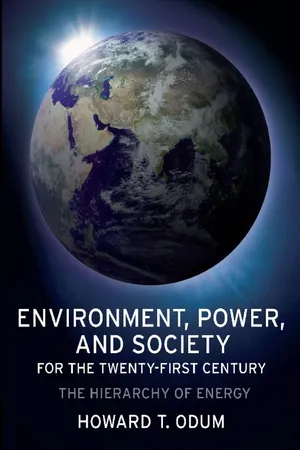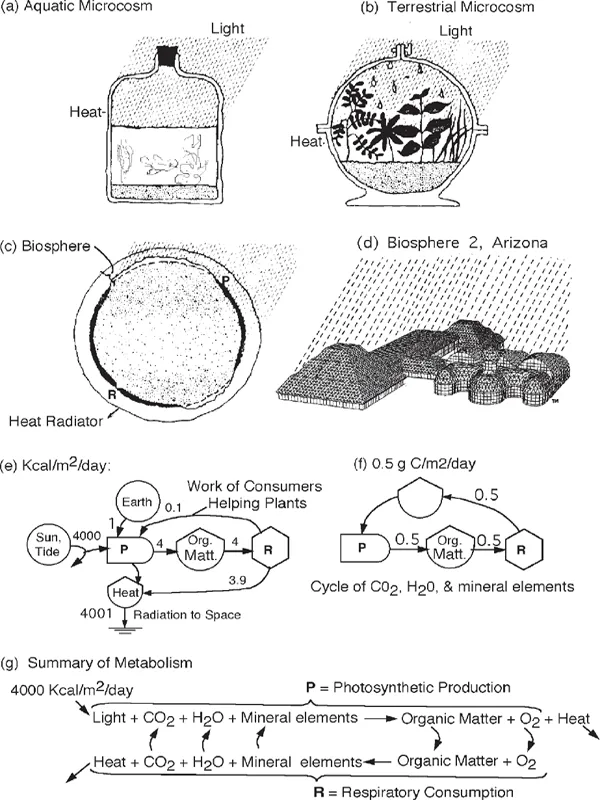![]()
CHAPTER 1
THIS WORLD SYSTEM
THIS BOOK is about nature and humanity. Nature consists of animals, plants, microorganisms, earth processes, and human societies working together. These parts are joined by invisible pathways over which pass chemical materials that cycle around and around, being used and reused, and through which flow potential energies that cannot be reused. The network of these pathways forms an operating system from the parts. Behavioral cues pass between animals; human discourse and money organize society. A study of humanity and nature is thus a study of systems of energy, materials, money, and information. Therefore, we approach nature and people by studying energy systems networks. The idea is to use general systems principles to understand and predict what is possible for society and environment.
Figure 1.1 shows the essence of our system of environment, power, and society. Energy from the sun and from the earth is running the landscape and its links to humanity. The quantity of useful energy determines the amount of structure that can exist and the speed at which processes can function. The small areas of nature, the large panoramas that include civilization, and the whole biosphere of Earth and the miniature worlds of ecological microcosms are similar.1 All use energy resources to produce, consume, recycle, and sustain.
FIGURE 1.1 System of environment, power, and society in the geobiosphere, which has inflowing solar energy, earth energy from below, cycling of materials, circulation of money, and feedback of human services to nature. This diagram, drawn by the author on a computer, is the logo for the Center for Environmental Policy at the University of Florida.
THE MACROSCOPE
In the 1600s, when Leeuwenhoek ushered in the Enlightenment through the study of the invisible world with the microscope, and when some of the atomistic theories of the Greeks received step-by-step observable verification in chemical studies, concepts of the structure and function of the natural world emerged as parts within parts within parts. Many of the advances of human civilization have come from these microscopic dissections. Yet in the 21st century the ever-accelerating knowledge of the microscopic view has not provided us with the solutions to problems with the human environment, social systems, economics, and survival, for the missing information is not wholly in the microscopic components or in identification of the parts. On the familiar scale of human life, we see the parts very well (people, economic assets, environmental components), but rarely do we think of it as a single-system operation. Pioneering thinkers such as V. I. Vernadsky (1926) recognized the intricate interdependence of humans in the processes of the earth, but many regard the scale of human life as free of controlling principles.
Astronomical systems, although infinitely larger, are seen through such distances that only the main features show (chapter 4). But on Earth, progress in understanding is slow because we are too close to see. As in the old adage about the forest and the trees, we cannot see the pattern for the parts. Figure 1.2 is a cartoon view of the steps we must take in going from detailed data to system viewing and prediction, a process we call using the macroscope. Whereas people often search among the parts to find mechanistic explanations, the macroscopic view is the reverse. Humans, already having a clear view of the parts in their fantastically complex detail, must somehow get away, rise above, step back, group parts, simplify concepts, and interpose frosted glass to somehow see the big picture.
FIGURE 1.2 Cartoon of the macroscope and the steps in its use. The detail eliminator simplifies by grouping parts into compartments of similar function.
Since Environment, Power, and Society was published, many sciences have found better lenses for the macroscope, better ways to see how the parts form larger wholes and patterns. Networks are better understood with new mathematics, models, and computer simulations that join the parts to show how the larger systems perform. The world is finally using the macroscope by viewing global problems on television, traveling worldwide, exchanging information on the Internet, and discussing global policies, politics, and international trade. The daily maps of worldwide weather, the information received from the high-flying satellites, macroeconomic statistical summaries, the combined efforts of international geophysical collaborations, and the studies of cycling chemicals in the great oceans all stimulate the new view.
In this book, therefore, the reader is invited to view the world and society through the macroscope. Many explanations use the principles of energy hierarchy (chapter 4). We hope to show the great wheels of the machinery in which we are small but important cogs and perhaps in the end predict how the earth will program human services in the drama of the earth.
THE BIOSPHERE
We can begin to gain a systems view of the earth by looking through the macroscope of the astronaut high above the earth. From an orbiting satellite, the earth’s living zone appears to be very simple (fig. 1.3c). The thin water- and air-bathed shell covering the earth—the biosphere—is bounded on the inside by dense solids and on the outside by the near vacuum of outer space. Past the orbiting capsule radiant energy from the sun enters the biosphere, and soon equal amounts pass outward as flows of heat radiation. Through the haze of height only a few features of energy flows can be observed. There is a great sheet of green chlorophyll and cyclones of spiraling clouds in weather belts, but the miraculously cascading machinery of parts within parts within parts is not even visible. From the heavens it is easy to talk of gaseous balances, energy budgets per million years, and the magnificent simplicity of the overall metabolism of the earth’s thin outer shell. With the exception of energy flow, the geobiosphere for the most part is a closed system of the type whose materials are cycled and reused.
The biosphere is the largest ecosystem, but the forests, the seas, and the great cities are systems also. Large and small parts operate on their budgets of energy, and what can and cannot be done is determined by energy laws (chapter 3). Any phenomenon is controlled both by the working of its smaller parts and by its role in the larger system of which it is a part.
FIGURE 1.3 Closed-to-matter systems supported entirely by sunlight and their metabolic reactions. (a) Aquatic closed system; (b) terrestrial microcosm; (c) biosphere of Earth; (d) Biosphere 2 in Arizona; (e) diagram showing energy flows for the systems (a–d); (f) cycle of materials between photosynthetic production (P) and respiratory consumption (R); (g) summary equations for photosynthetic production and the reverse process of respiratory consumption.
The work that results from energy flow is inherently hierarchical, with many calories of one kind required to produce a few calories of another. Much of the organization of the geobiosphere and the human economy is understandable from the energy hierarchy concepts (chapter 4).
In earlier times, energy available to human management was insufficient to control the biosphere, and people were protected in their ignorance by the great stabilizing storages of the oceans and atmosphere. In recent years, however, the accelerating growth of fossil fuel use has allowed civilization to interfere with life support, outdistancing our knowledge of the consequences. The gaseous emissions of civilization are changing the climate (chapter 5).
THE LIVING METABOLISM OF THE EARTH
With the turning of the earth, the sun comes up on fields, forests, and fjords of the biosphere, and everywhere within the light there is a great breath as tons upon tons of oxygen are released from the living photochemical surfaces of green plants, which are becoming charged with food storages by the onrush of solar photons. Then, when the sun passes in shadows before the night, there is a great exhalation of carbon dioxide (CO2) that pours out as the oxygen (O2) is burned, the net result of the maintenance activity of the living machinery. During the day, while oxygen is generated, a great sheet of new chemical potential energy in the form of organic matter lies newborn about the earth, but in the darkness, the new organic matter and oxygen disappear in hot and cold consumption processes that release heat through the night. Figure 1.3e and 1.3g summarizes earth metabolism.
The living process in green chlorophyll of forests, lakes, oceans, and deserts during the day is called photosynthesis by those who study a small segment of it and primary production by those who consider great masses of it. In photosynthetic production (abbreviated P in fig. 1.3), carbon dioxide, water, and nutrients are combined to make organic matter and oxygen.
Consumption of organic matter and oxygen by living organisms and by cities goes on day and night but is masked by primary production of these substances during the day. It can be measured at night. Although respiration usually is used for the cool fires of biological consumption, let us also allow the word to include consumption by the hot fires of autos and industry. The letter R is the abbreviation used here for all such consumption. Respiration transforms the energy of food and fuel consumption into useful work when the organic molecules are combined with oxygen to make carbon dioxide and water (fig. 1.3g). In the overall equation for consumption, materials are returned to the inorganic state, ready for primary production again (fig. 1.3f). The materials generated by consumption are the ones used by production and vice versa.2
The average P and R of the biosphere has been about 1 g of organic matter per square meter per day. This is about 4 kcal of organic potential energy stored daily as organic matter and burned again later (Behrenfeld et al. 2001). Together the P and R processes generate a cycle of materials. Systems running on sunlight that are closed to matter tend to develop a balance between production and consumption. Like the biosphere, three other solar-based systems that are mostly closed to matter are shown in fig. 1.3: an aquatic microcosm, a terrestrial microcosm, and the 3-acre Biosphere 2 in Arizona (Marino et al. 1999).
RESOURCES FROM ABOVE AND BELOW
About half of the energy that comes to the earth from the sun is in the visible wavelengths, which are used in photosynthesis. The other part of solar energy is in infrared and ultraviolet light wavelengths that are absorbed as heat in the ocean, soils, and vegetation. This directly absorbed heat, plus the heat released from photosynthetic machinery using the visible wavelengths, plus heat released when organic matter is consumed, all add together to cause higher temperatures near the equator and lower temperatures in shaded regions. Between high- and low-temperature areas a giant heat engine operates, creating the great wind and water current systems of the earth. The energies processed by the earth’s heat engines contribute to photosynthetic and respiratory processes by causing winds and water currents to bring raw materials such as rain and fertilizer minerals more rapidly to the plants for production.
Some of the sun’s heat drives the plant’s uptake of water from the soil and the transpiration of...



